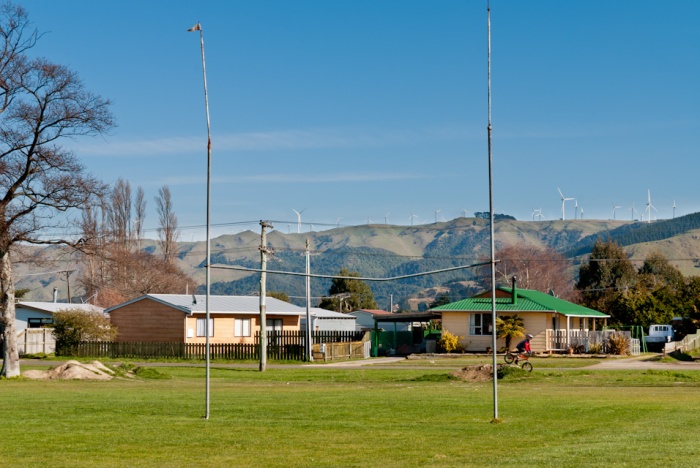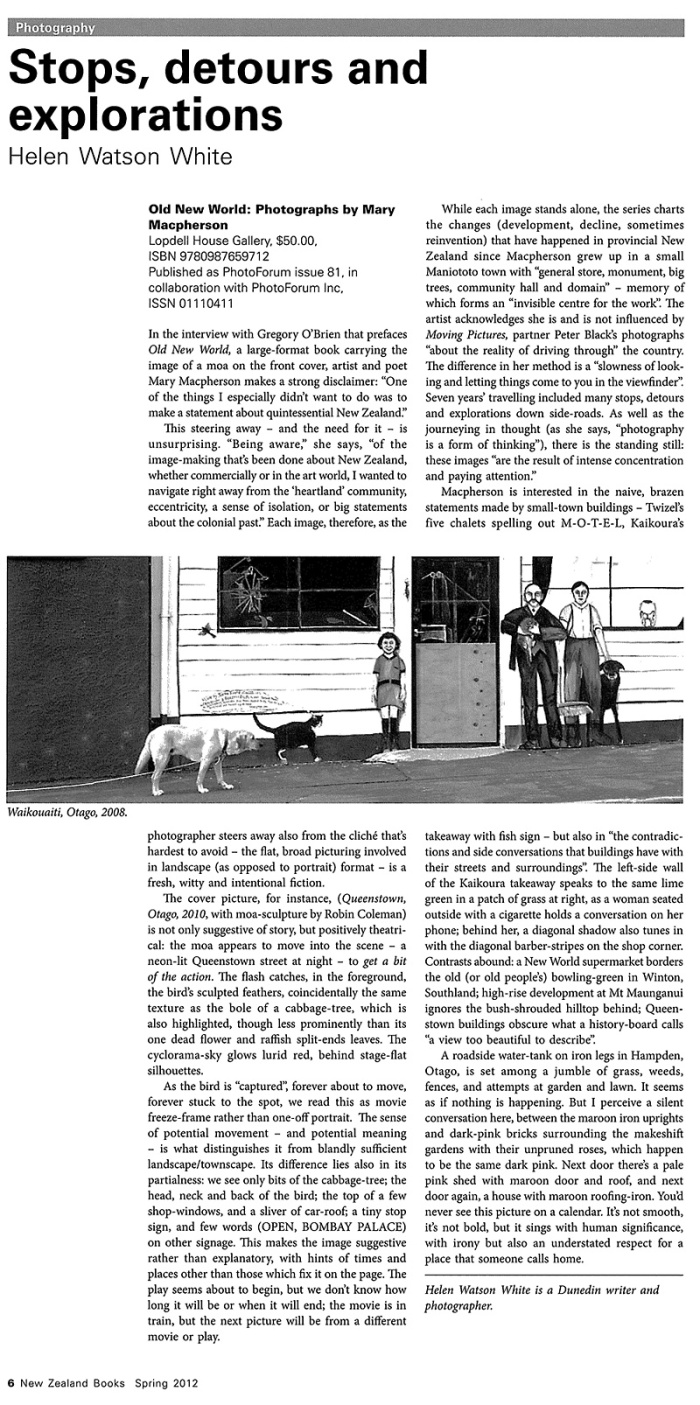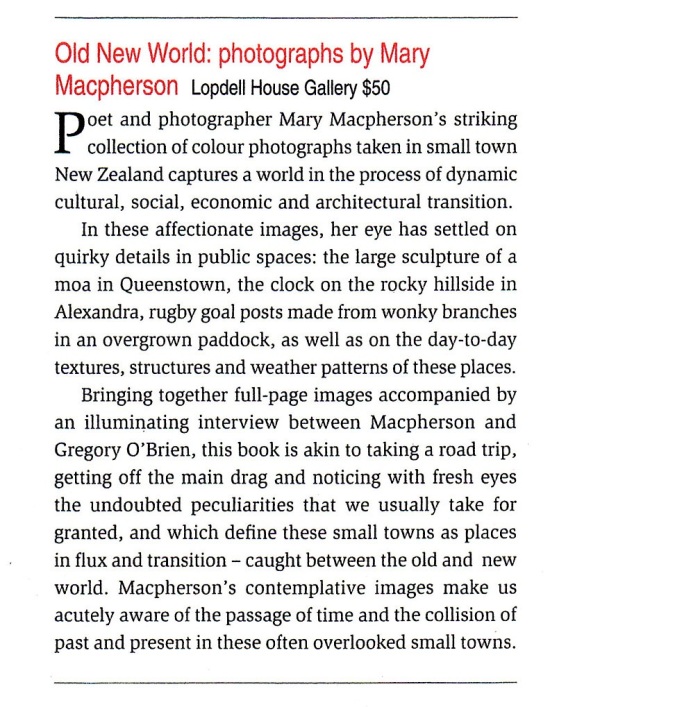Old New World

Old New World cover. Queenstown, Otago, 2010 (Image copyright Mary Macpherson). Design: Lesley Smith.
Old New World is the book of my photographs about change in New Zealand society as seen in small towns throughout the country (pub Lopdell House Gallery, now Te Uru). It was launched in 2012 at Lopdell House in conjunction with my exhibition during the Auckland Festival of Photography. The quality hardback publication features 62 images and an interview between myself and Gregory O’Brien.
I worked on the project for several years – making journeys around the country whenever I could – photographing, and then spending long periods thinking about what I was doing.
The photographs feature buildings, houses, statues and murals to tell the story of a shift from the remains of the traditional New Zealand of the 1950s and 60s to places of boom and prosperity that look very different to our remembered past. Within that narrative arc, the work also shows the major social and economic trends I saw – towns painting up the main street to attract custom and celebrate their identity, places that remained resolutely themselves and those that were heading into decline.
I became fascinated with the artworks, promotions and murals that have sprung up and which refer to national or regional history, or slices of New Zealand identity. I wanted to show how we were representing ourselves and how those representations sat in their surroundings.

Feilding, Manawatu-Whanganui,2009. From Old New World. (Image copyright Mary Macpherson.) (Sculpture by John Fuller)
Distance
One of the things that was important in making the Old New World photographs was to have a sense of distance and wholeness in the photographs. Sometimes this meant citing a building or structure within a complete landscape, or including the conversations that a building has with its surroundings. I wanted this large scale, in part, to show the layers of time and history and development that sit within a townscape, and to cite things within their everyday context. Photographs can easily narrow down a on building or work, to make it look gothic or highly charged, but I wanted the work to be a conduit for thinking about the significance, and often beauty, of things we encounter when we are just walking down the main street.
In the image below taken in Woodville, I really liked the constrast between the battered rugby goalposts (very much part of New Zealand tradition) and the green future represented on hills by the wind turbines. In between a young boy gets on with life, riding his bike over the bumps.
The unexpected
When I was photographing, I was focused on trying to find the direction for the work and making pictures that expressed their intention properly. I didn’t expect over the years I photographed that some images might become a record of things that disappeared. This is probably naive on my part, as if my loving a building or a sign would preserve it when the communities that support activities and buildings change or disappear.
One building that I didn’t ‘save’ was a long skinny Legion of Frontiersmen building in a small Wairarapa town. It was painted in yellow and brown with the Legion’s insignia on the front, and just one narrow door for entry. With my then film camera I spent quite a lot of time photographing it one afternoon. But in the end I wasn’t satisfied with the pictures and decided to go back and re-photograph. By the time I arrived back, perhaps a couple of years later, it was just a long skinny building painted grey. The most recent time I drove past it was quite a cheerful day care centre.
One building and sign that did make it into the book was an old boxing club in Alexandra in Central Otago.
The building, which was built of stone, was already damaged when I photographed it – the side stone wall had a huge hole in it (one of my friends commented that perhaps a boxer had punched their way out).
It was near eight o’clock at night when I photographed it, and with the sun zipping in and out from behind clouds, it was quite a difficult picture to make.
When I came back to Alexandra in 2010 one of the first things I wanted to do was go back to the boxing club building. But when I arrived there the building was three-quarters demolished. Of the boxing mural – only the feet remained.
Knowing the sun would be on it in the evening, I decided to go back around the same time and photograph the remains. When I returned in the evening a car was parked hard up against the building! There was just room for me and my monopod to slip in and make pictures – even in its death throes the building was difficult, and still giving pleasure.
The man whose car was parked in front returned and remarked that it had been a ‘good old boxing club’.
Time and Change
At its heart, Old New World is a work about time and change. During one interview I was asked if the work was part nostalgia. But it’s not that. It’s more about seeking my place in a world that has changed. I felt as if being a witness to social change that had occurred in my lifetime as represented in buildings, street, artworks, etc – the public containers of our history and identify – helped me understand and accept the passing of time. In that sense photography is a form of thinking and self-discovery.
Images about time became important symbols in the book. The opening photograph of the book sequence is of a traditional-type town clock in Foxton. In the introduction Gregory O’Brien wrote of this image: “We arrive at the first photograph in this series at 4.18pm-as registered on the Foxton town clock, which hovers at the centre of the image like a sun or moon….Time presides over the first image as, more obliquely, it does over all the subsequent photographs.”
Later in the book, in the section that deals with places that have been changed or transformed through development, there’s an image of a town clock from Wanaka.
To buy the book ask at independent bookshops nationally or Photospace Gallery. For print orders contact Photospace Gallery, Wellington.
Media
Stories and reviews about Old New World –
Here’s a link to my interview with Kathryn Ryan on RNZ Nine to Noon.
Stories are in North and South (June/July 2012), Your Weekend (Dominion Post/Stuff, 7 July) and photographs/writing in Booknotes (Autumn/Winter 2012) and Takahe (December 2012). Wellington poet Janis Freegard has posted this interview with me on her blog.
Reviews have appeared in the print issues of DPhoto (June/July 2012), Landscape Architecture NZ (June 2012)
Online there are reviews by:
David Eggleton in Landfallreviewonline (1 Oct 2012)
“…she knows how to slow down and just gaze and get that into her photographs – this arrested movement testified to in a photograph of spindly rugby goalposts, with stick-like wind turbines stock-still on a hilltop behind – so that the stillness accumulates and transforms into a crystalline epiphany.” Read more
Maurice Lye in Takahe 76 (Spring 2012)
“The featured buildings don’t stand alone; they’re part of a wider context: landscape, community and history. Macpherson sees this connection and skilfully includes enough of the surroundings to
help anchor each in their place.” Read more
and Andy Palmer in Lumiere Reader (8 Sept 2012)
” Old New World, Real Time’ (the essay) could stand alone from Old New World (the book) and not be entirely out of context. It’s a short piece but it covers a lot of ground, including Macpherson’s earlier works and her influences. It is also an enlightening conversation about the nature of photography and the thought processes of a project-based photographer.” Read more
Below are reviews from New Zealand Books by Helen Watson White (NZ Books), and from Art News (Art News).
Review of Old New World from New Zealand Books, Spring 2012
To return to the blog click here.







[…] There’s also more on this site. […]
Welcome « Mary Macpherson
06/04/2012 at 11:41 am
[…] learn more about the role of time in the Old New World work, go to the Old New World page. Share this:ShareFacebookTwitterEmailLike this:LikeBe the first to like this […]
Foxton clock in Old New World « Mary Macpherson
13/05/2012 at 5:16 pm
[…] Article source: Lopdell House Gallery Visit Mary Macpherson’s Blog […]
photoforum-nz.org » Blog Archive » Lopdell House Gallery: Upcoming exhibition & publication by Mary Macpherson
14/05/2012 at 2:42 pm
Hello Mary MacPherson.
I look forward to seeing your images at Lopdell House and hearing your poetry at Rhythm & Verse.
– Madeleine Slavick
(I also have a blog: http://touchingwhatiloveblogspot.com)
Madeleine Slavick
12/06/2012 at 10:24 am
[…] look at change in small towns in New Zealand; more information is available at Mary’s blog, here – and in an interview on Radio New Zealand’s Nine to Noon programme on 12 June, available, at […]
Two Notes « rumbleinthejumble
13/06/2012 at 9:43 pm
[…] more information and reviews about Old New World click here. Share this:ShareFacebookTwitterEmailLike this:LikeBe the first to like […]
Review of Old New World « Mary Macpherson
04/09/2012 at 6:24 pm
[…] example is Mary Macpherson’s Old New World, a book of her photographs made over seven years about change in New Zealand society as seen in […]
critical writing about photography - Thought FactoryThought Factory
17/12/2015 at 1:56 pm
[…] Reading the recent piece in The Spinoff about the looming effects of Queenstown’s tourist boom made me think of this photograph from my book Old New World. […]
New world old uses | Mary Macpherson
14/12/2016 at 12:41 pm